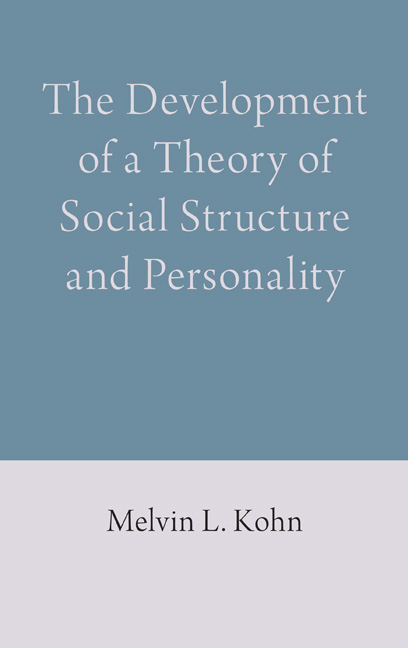Book contents
- Frontmatter
- Contents
- Preface
- 1 Hagerstown and Schizophrenia
- 2 Social Stratification and Parent–Child Relations in Washington, DC
- 3 The Torino Study
- 4 Men Employed in Civilian Occupations in the United States
- 5 The Transformation of the Occupations Study into a Longitudinal Analysis
- 6 Life on Sabbatical Leave in Norway and at the National Institute of Mental Health
- 7 Class, Stratification, and Personality
- 8 Poland under Communism
- 9 Occupational Self-Direction and Distress in Poland
- 10 The Vietnam War, Nixon, and Me
- 11 Japan
- 12 Germany – West and East
- 13 Poland and Ukraine in Transition to Capitalism and Democracy
- 14 The Presidency of the American Sociological Association, Ronald Reagan, and My Job Switch
- 15 My Two Exploratory Expeditions to China
- 16 China in Transition to a Modern Economy
- 17 Retirement, and My Last Sabbatical, at Deep Springs Junior College
- 18 The Theory I Propose
- Index
9 - Occupational Self-Direction and Distress in Poland
Published online by Cambridge University Press: 12 July 2019
- Frontmatter
- Contents
- Preface
- 1 Hagerstown and Schizophrenia
- 2 Social Stratification and Parent–Child Relations in Washington, DC
- 3 The Torino Study
- 4 Men Employed in Civilian Occupations in the United States
- 5 The Transformation of the Occupations Study into a Longitudinal Analysis
- 6 Life on Sabbatical Leave in Norway and at the National Institute of Mental Health
- 7 Class, Stratification, and Personality
- 8 Poland under Communism
- 9 Occupational Self-Direction and Distress in Poland
- 10 The Vietnam War, Nixon, and Me
- 11 Japan
- 12 Germany – West and East
- 13 Poland and Ukraine in Transition to Capitalism and Democracy
- 14 The Presidency of the American Sociological Association, Ronald Reagan, and My Job Switch
- 15 My Two Exploratory Expeditions to China
- 16 China in Transition to a Modern Economy
- 17 Retirement, and My Last Sabbatical, at Deep Springs Junior College
- 18 The Theory I Propose
- Index
Summary
We had been developing the idea of occupational self-direction ever since the Torino study, then only with crude indices, but we later developed those indices considerably. In the study of men employed in civilian occupations in the United States, we developed a fully serviceable index of the substantive complexity of work and reasonably adequate indices of closeness of supervision and routinization. With these indices, we were able to demonstrate that statistically controlling these facets of occupational self-direction explained sizable portions of the relationships of social stratification with psychological functioning. With the advent of longitudinal analysis and of linear structural equations causal modeling, we were even able to show not only that occupational self-direction largely explained the effects of social stratification, and now also of social class, on psychological functioning, but that even in models that allowed for reciprocal effects of occupational self-direction on personality and of personality on occupational self-direction, occupational self-direction actually affected personality. In fact, these effects were even larger than we had previously found with more primitive methods. But we had not yet shown that any of this was true of countries other than the United States. And we did not really know what besides occupational self-direction mattered. Our finding of opposite relationships between class and stratification with distress for the United States and Poland raised the interesting question of what, besides occupational self-direction, explained the relationship between social structure and distress.
We had the opportunity to deal with both questions in the Polish study.
First of all, of course, we needed a good index of occupational selfdirection for Poland. We opted, essentially, for using much the same index as we had used in the United States. The issues of the meaning of terminology in the questions about values for children and about orientation to self and others that so concerned us in developing indices of those questions was not at issue here. We had used a much more direct procedure of asking descriptive questions about relatively clear-cut issues. Both the US and Polish indices of occupational self-direction fit their respective variance–covariance matrices well. The parameters of the models were quite similar in the two countries, with the substantive complexity of work by far the most powerful component of occupational self-direction.
- Type
- Chapter
- Information
- Publisher: Anthem PressPrint publication year: 2019



